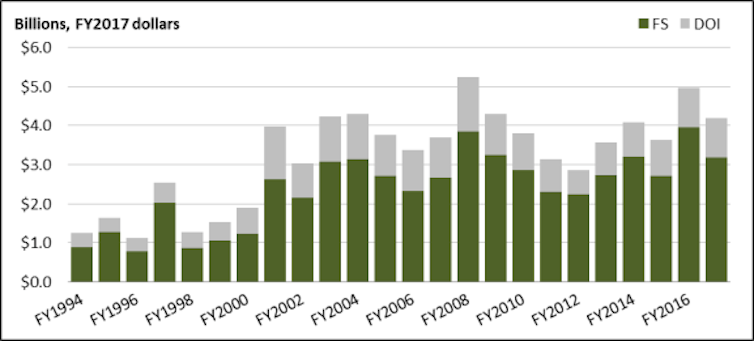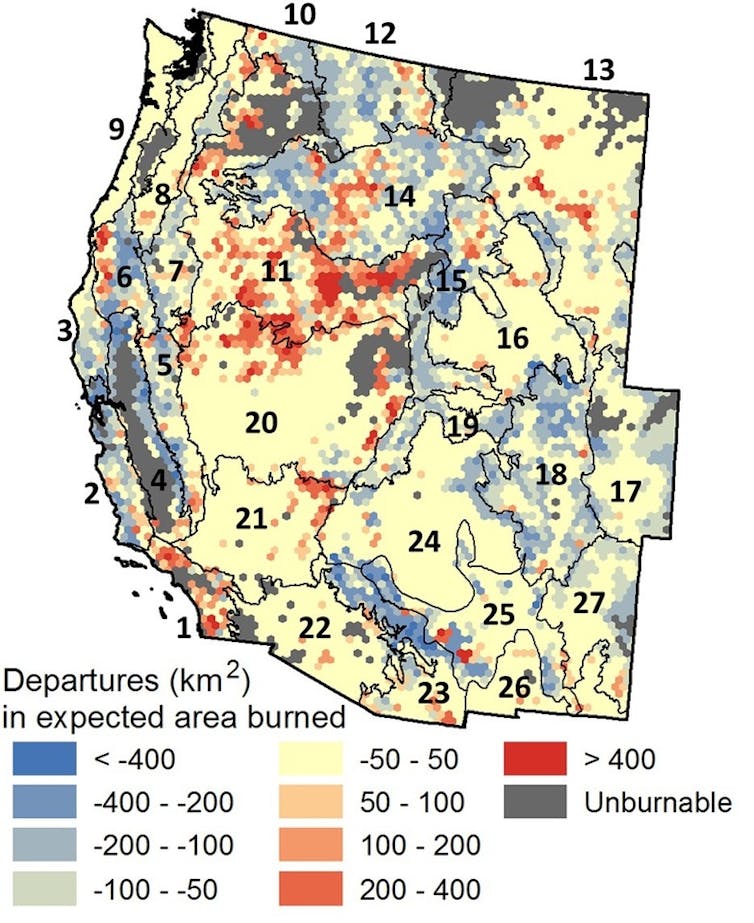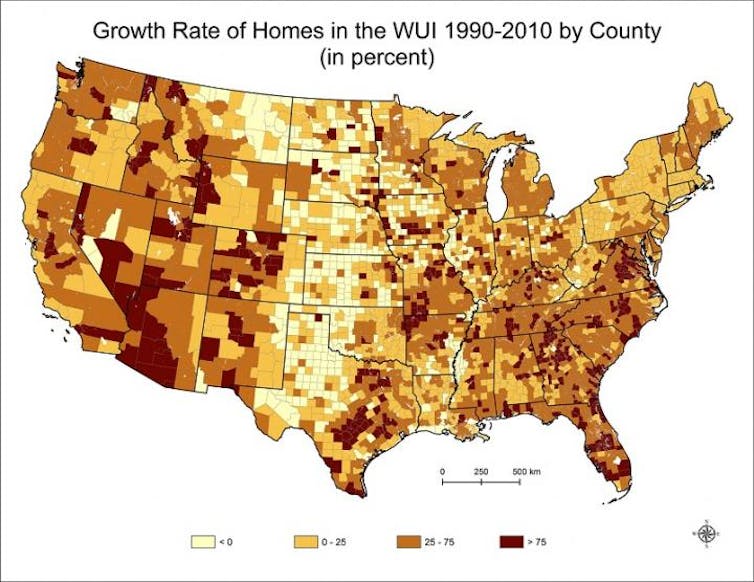Cassandra Moseley, University of Oregon
Just six months after the devastating Thomas Fire – the largest blaze in California’s history – was fully contained, the 2018 fire season is well under way. As of mid-July, large wildfires had already burned over 1 million acres in a dozen states. Through October, the National Interagency Fire Center predicts above-average wildfire activity in many regions, including the Northwest, Interior West and California.
Rising fire suppression costs over the past three decades have nearly destroyed the U.S. Forest Service’s budget. Overall funding for the agency, which does most federal firefighting, has been flat for decades, while fire suppression costs have grown dramatically.
Earlier this year Congress passed a “fire funding fix” that changes the way in which the federal government will pay for large fires during expensive fire seasons. This is vital for helping to restore the Forest Service budget. But the funding fix doesn’t affect the factors that drive costs, such as climate trends and more people living in fire prone landscapes.

More burn days, more fuel
Why are costs increasing so dramatically? Many factors have come together to create a perfect storm. Climate change, past forest and fire management practices, housing development, increased focus on community protection and the professionalization of wildfire management are all driving up costs.
Fire seasons are growing longer in the United States and worldwide. According to the Forest Service, climate change has expanded the wildfire season by an average of 78 days per year since 1970. Agencies need to keep seasonal employees on their payrolls longer and have contractors standing by earlier and available to work later in the year. All of this adds to costs, even in low fire years.
In many parts of the wildfire-prone West, decades of fire suppression combined with historic logging patterns have created small, dense forest stands that are more vulnerable to large wildfires. In fact, many areas have fire deficits – significantly less fire than we would expect given current climatic and forest conditions. Fire suppression in these areas only delays the inevitable. When fires do get away from firefighters, they are more severe because of the accumulation of small trees and brush.

Protecting both communities and forests
In recent decades, development has pushed into areas with fire-prone ecosystems – the wildland-urban interface. In response, the Forest Service has shifted its priorities from protecting timber resources to trying to prevent fire from reaching houses and other physical infrastructure.
Fires near communities are fraught with political pressure and complex interactions with state and local fire and public safety agencies. They create enormous pressure on the Forest Service to do whatever is possible to suppress fires, which can drive up costs. There is considerable pressure to use air tankers and helicopters, although these resources are expensive and only effective in a limited number of circumstances.
As it started to prioritize protecting communities in the late 1980s, the Forest Service also ended its policy of fully suppressing all wildfires. Now fires are managed using a multiplicity of objectives and tactics, ranging from full suppression to allowing fires to grow larger so long as they stay within desired ranges.
This shift requires more and better-trained personnel and more interagency coordination. It also means letting some fires grow bigger, which requires personnel to monitor the blazes even when they stay within acceptable limits. Moving away from full suppression and increasing prescribed fire is controversial, but many scientists believe it will produce long-term ecological, public safety and financial benefits.

Professionalizing wildfire response
As fire seasons lengthened and staffing for the national forest system declined, the Forest Service was less and less able to use national forest as a militia whose regular jobs could be set aside for brief periods for firefighting. Instead, it started to hire staff dedicated exclusively to wildfire management and use private-sector contractors for fire suppression.
There is little research on the costs of this transition, but hiring more dedicated professional fire staffers and a large contractor pool is probably more expensive than the Forest Service’s earlier model. However, as the agency’s workforce shrank by 20,000 between 1980 and the early 2010s and fire seasons expanded, it had little choice but to transform its fire organization.

Few opportunities for cost control
Many of these cost drivers are out of the Forest Service’s hands. The agency may be able to have some impact on fire behavior in certain settings, with techniques such as hazardous fuels reduction and prescribed fire, but these strategies will further increase costs in the short and medium term.
Another option is rethinking the resources for wildfire response. While there are almost certainly savings to be had, capturing these savings will require changes in how society views wildfire, and political courage on the part of the Forest Service to not use expensive resources on high-profile wildfires when they may not be effective.
Even if these approaches work, they will likely only slow the rate of increase in costs. Climate change, the fire deficit on many western lands and development in the wildland-urban interface ensure that continued cost increases are baked into the system for decades to come.
![]() Wildfire fighting costs now consume more than half of the agency’s budget, reducing funds for national forest management, research and development, and support for state and private forestry. Even if it doesn’t lower costs, the fire funding fix is vital because it will help create space in the Forest Service budget to fund the very activities that are needed to address the growing problem of wildfire.
Wildfire fighting costs now consume more than half of the agency’s budget, reducing funds for national forest management, research and development, and support for state and private forestry. Even if it doesn’t lower costs, the fire funding fix is vital because it will help create space in the Forest Service budget to fund the very activities that are needed to address the growing problem of wildfire.
Cassandra Moseley, Associate Vice President for Research and Research Professor , University of Oregon
This article was originally published on The Conversation. Read the original article.

